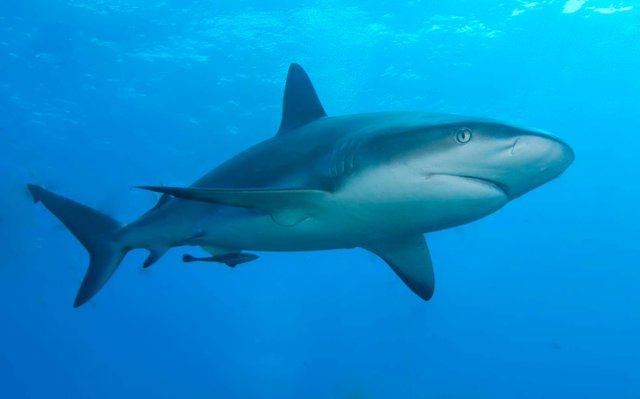Tree of Life: Where did bones come from?
I really enjoyed researching & writing this post for some reason ^__^
Last week, we looked at a progression of life from protostomes to jawed fish and we hit a crossroads where fish divided into the categories of bony and boneless. I was suddenly very intrigued at how and why this happened.
Today, some extant examples of boneless, or cartilaginous fish, is the shark, the sawfish and stingray, and for an extinct example, how about this incredibly bizarre and hard-to-explain creature, the helicoprion:

What a life that guy must have led (I'm still not convinced that's the set up).
Examples of bony fish would be, well, fish. You know, tuna and whatnot.
We should all be loosely aware that we descended from fish in one way or another, so it's reasonable to suggest we came from the bony ones. But why did bones form instead of cartilage which clearly is a working model even to this day?
Cartilage
Let's go with the shark. Aside from the current day where humans are rendering them extinct within a century or so in order to enjoy some tasteless soup, sharks have thrived for millions of years, unchanged and unevolved that whole time...Or so we thought.

The problem is, cartilage doesn't preserve as well as bone, so it's a lot harder to keep a good track record of their history. Cartilage is more of a kind of rubbery tissue that in bony creatures, gets replaced with bones once the 'frame' is set (aside from like, our noses and whatever)
But sharks never evolved it into bone... why?
For a long time, researchers just kind of assumed sharks were a primitive remnant, a 'living fossil' as they like to say. They simply managed to survive with old material. But recently, this has been entirely overturned.
To AUSTRALIA!

After 60 years of coming up blank, one archaeological site in Western Australia, the Gogo Formation brought up some ancient shark fossils that were very interesting indeed. Not only was it a unique find in an ocean of fossils that were rich in fauna but up to this point lacking in sharks, but they found that the 380 million year old cartilage was very much like modern day shark's cartilage. On top of this, the matrix holding the cartilage together had bone cells visible within its structure - something absent in modern day sharks.
Long story short, this discovery made us realise that sharks had at some point developed bones, and had since lost them in favour of cartilage, making them a lot more up-to-date evolutionarily than we're always taught in school.
It seems likely that sharks would have done this to gain an advantage in the speed and flexibility* departments, enhancing their hunting abilities. A rubbery, lightweight skeleton would be far better than a hefty, stiff one in the case of big ocean dwelling hunters.
But the part that interests me most here is that there were cells within the cartilage structure that resembled bone cells. Is this to say they evolved together? First:
Bone

Bone has only been around about half a billion years, and has served very useful not just as a structural tool, but a defensive one. Unique to vertebrates, studies suggest bone wasn't even a possible option for the longest time, and the reason is likely to do with oxygen.
Today, our atmosphere is about 20% oxygen, but back in the day, this number was closer to 0.1%. Then, a so far mysterious period called The Great Oxygenation Event occurred about 2.5 billion years ago, and oxygen started to rise significantly. boom, just like that. I guess a little more complicated.
This changed the chemistry of the oceans, rocks and beyond. For example, Dolomite (CaMg(CO3)2) was a mineral dominating rocks before the oxygen rise, but these rocks were largely replaced by limestone, a rock rich in both Aragonite and Calcite (CaCO3 - two different crystal forms of the same mineral).
This was an important advancement for the formation of bone (I bet you thought I was going off on some unrelated tangent), because Calcium Carbonate crystals can form quickly and with little energy compared to that of Dolomite. To add to this, the continental erosion of I suppose billions of tonnes of Calcium would have washed away and filled the seas with the much needed ingredients.
This new technology was now abundant and animals were (in perspective) quick to take advantage in a kind of skeleton revolution. This has been confirmed in the fossil records, with soft bodied creatures in the days of Dolomite and skeleton animals during the later Limestone days. After that, evolution continued to do its work and, well, here we are!
Bones vs Cartilage
In the family tree of life, both bony and cartilage fish evolved from a common ancestor called Placoderms, an armour plated fish that represents one of the earliest jawed fish dating back to about 420 million years ago - well into the oxygenation bony era.
To CHINA!

Qujing, China.
In 2013, a fossil was found in Qujing, China called Entelognathus. This animal is interesting in that it seems somewhat hybridised. the neck, body and tail are reminiscent of the Placodermi, but the head and its bone patterns looked like modern day fish. This gave some insight as to how skeletons formed; head first.

The timeline was once thought to be something along the lines of the placodermi evolving a primitive bony structure, animals then losing this and then re-evolving modern-day bones. Meanwhile, sharks and other cartilaginous fish didn't bother and just lived with their rubbery bones.
Our new understanding shows that the Placodermi skeleton simply evolved into modern day skeletons face first, This also adds to the argument that sharks are actually more evolved in this regard than we, having since done away with bones in favour of cartilage at some later date which, if you remember above, was probably around 380 million years or so ago compared to bones at 420 mya.
So there you have it
Bone evolved when the chemical properties of the earth were changed by some currently unexplained event allowing bones to form, and modern bones formed face first in an old fish. Cartilaginous skeletons actually came after the bony structures, split from us on the evolutionary tree to sharks, and we continued with the old model.
You may notice that I didn't write about where cartilage actually came from, and that's because this is another unexplained gap in our knowledge, precisely because it doesn't fossilize as well as bone. But evidence suggests cartilage was indeed a precursor to bones and vertebrates. But since we're not following the path of cartilaginous fish, I'm not going to dig anymore into it (for now. I'm legitimately curious).
I'd like to point out once again that much of this information is buried in questions, controversy and mystery that we are, as a species slowly picking apart and becoming increasingly objective towards, but the more we learn, the more questions arise; When exactly did bones come to exist? Did bones evolve once, or multiple times? What molecular mechanisms made our soft tissue become hard? And so on. I guess we'll just have to live a thousand more years to find all this stuff out. But rest assured, we will find out.

All Images CC Licensed
References: Shark Cartilage | Gogo formation | The Late Devonian Gogo Formation Lägerstatte of Western Australia: Exceptional Early Vertebrate Preservation and Diversity | The Great Oxygenation Event | How animals got skeletons | Face First skeletal evolution | Placodermi | Osteogenesis: The Development of Bones
I did posts on both Helicoprion and the placoderms a while back, I'm a huge fan of both! I'm actually planning on getting a Dunkleosteus tattoo eventually.
Haha, just armour plate your head and it should look more or less the same =D
That is pretty interesting regarding the great Oxygenation event and it's impact on the formation of bones. It makes you think how many different events had to happen for us to evolve into what we are now.
Well that's exactly what this series is about =) almost 10 episodes so far and we haven't even left the water yet =/
I feel sorry for whoever is bitten by that mouth
To listen to the audio version of this article click on the play image.

Brought to you by @tts. If you find it useful please consider upvote this reply.
Wow! Really! This audio translation is so cool :)
I love reading about these animals just for the pleasure, not for studying. Its like jurassic park over again. They are so big. The changes thst brought us to this point, both biologically physiologically and cellularly is stunning.
It really gives you a sense of how little sense of time we actually have, too. We don't appreciate how much time life had to come up with these innovations... crazy stuff
I have been here since 1.5 month .To be honest, for the first time i enjoyed reading something.Superb......keep it up.
That's good to hear! This is like episode 10 of a whole series, so feel free to look it up from the very beginning ^__^ It's all very fascinating from my point of view; learning as I go
Yeah sure.
This is such a well-written post! I am usually not interested in such topics, but the research in this one and the way you have written it compelled me to go through the entire piece.
Thanks! I try my best to write otherwise boring stuff in a way that can compel an audience... kinda the tricky part of it all!
I'm really enjoying this series. I have just tried the @tts audio though. PAH! Because I know you and read it in 'your voice' I couldn't listen to the robotic female. It's very good for those who haven't time/opportunity to read though. That aside I am learning so much and asking much more. Looking forward to the next one. I do wonder why noses don't have bone though?...
Yeah I try to make it sound like the way I'd talk, probably the most appealing way in my opinion. Next one coming out today! If I don't fall asleep... just went skateboarding for about 7 hours and I'm dead...Thanks got I have FOUR LIMBS to balance with
Now I know why I was always seeing photos of that Entelognathus fish throughout high school and university.
Why did evolution transform a four-limbed, tree-dwelling ape, into a ground dwelling biped?Evolutionists often claim that universal common ancestry and the “tree of life” are established facts. But what is the evidence of their claim.
As explained in this series, much of the tree is not estatblished fact - yet. We have a lot more work to do. But the fact that there is a tree of life is a fact, the evidence is literally everywhere, including this so far 8-9 episode series that you're free to read about.
Since I haven't gotten out of water yet, I don't want to talk about bipedal mammals yet. I'll save for a later episode